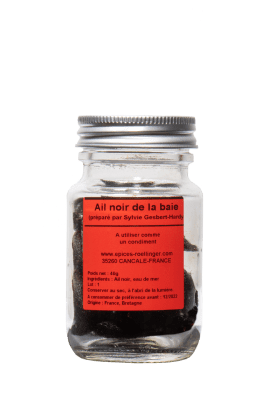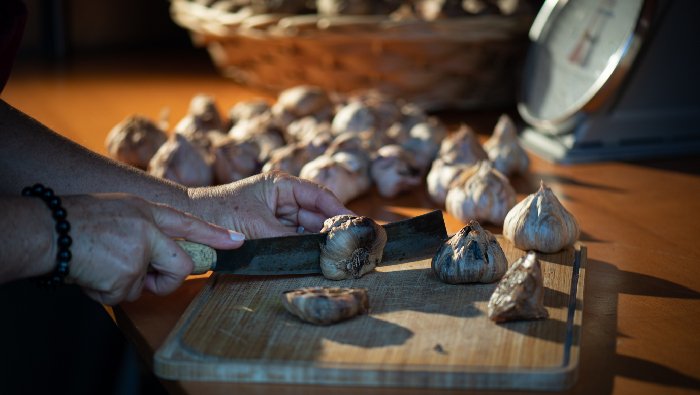Black Garlic from the bay (aged by Sylvie Gesbert-Hardy)

Ingredients: Black garlic, sea water.
Thinly slice. Use as a seasoning or garnish.
€12.50
40 g
Recommendations
Count 1/2 black garlic clove per person. Thinly slice. Avoid exposing black garlic to direct heat. Black garlic is divine when it is scattered over a slice of buttered toast. Use black garlic slices as a finishing touch for cheese plates as well as fish and chicken dishes. Sprinkle over salads, creamy pasta dishes, and risotto. Add to scallop, fish, and black radish carpaccios and ceviches.
Hugo Roellinger likes to blend black garlic into mashed potatoes or cauliflower just before serving. Crush black garlic with a mortar and pestle, then add to the pan juices of roasted meats. Daring food lovers will want to experiment with black garlic in chocolate-based desserts and fruit salads.
Hugo Roellinger likes to blend black garlic into mashed potatoes or cauliflower just before serving. Crush black garlic with a mortar and pestle, then add to the pan juices of roasted meats. Daring food lovers will want to experiment with black garlic in chocolate-based desserts and fruit salads.
Perfume
Black garlic cloves' soft flesh has licorice, balsamic vinegar, and prune flavor notes with hints of umami.
Our recipes
-
Allergens
Absent, except for cross-contamination.
May contain traces of sesame, celery, mustard, soy. - Origin France, Bretagne
- Storage / Use In a cool, dark, dry place.
€312.50 / kg
Olivier Rœllinger's words
Our garlic is sourced from the Mont-Saint-Michel Bay area, where it is cultivated by a family of growers committed to sustainable farming for many years. The rich coastal soil and sea breezes yield plump cloves with a whiff of sea spray in their flavor profile.
At the Maisons de Bricourt, garlic is inextricably linked to the Mont-Saint-Michel Bay. Just beyond the rocky cliffs of Cancale, a flat landscape of polders and vegetable fields unrolls itself like a richly fertile carpet. There, the loamy soil is home to thriving crops of carrots, potatoes and garlic.
The fields continuous exposure to misty sea breezes make them particularly suited to growing garlic, a sought-after local delicacy since the end of the Second World War.
Our supplier, Sylvie Gesbert-Hardy, takes great care when curing the white garlic grown in the Bay area into black garlic cloves. Following a successful career in in the public utilities sector, Sylvie decided to start a new life chapter and make the switch to producing black garlic. It all began while she was watching a TV segment on the benefits of black garlic. For the past three years, she has become an expert on the superfood, and she has put her expertise into practice to bring out the best in the black garlic she produces in her workshop.
At the Maisons de Bricourt, garlic is inextricably linked to the Mont-Saint-Michel Bay. Just beyond the rocky cliffs of Cancale, a flat landscape of polders and vegetable fields unrolls itself like a richly fertile carpet. There, the loamy soil is home to thriving crops of carrots, potatoes and garlic.
The fields continuous exposure to misty sea breezes make them particularly suited to growing garlic, a sought-after local delicacy since the end of the Second World War.
Our supplier, Sylvie Gesbert-Hardy, takes great care when curing the white garlic grown in the Bay area into black garlic cloves. Following a successful career in in the public utilities sector, Sylvie decided to start a new life chapter and make the switch to producing black garlic. It all began while she was watching a TV segment on the benefits of black garlic. For the past three years, she has become an expert on the superfood, and she has put her expertise into practice to bring out the best in the black garlic she produces in her workshop.


Story
White garlic is an annual plant that grows from a bulb (or head) which is divided into several cloves. 'Skorodon,' the Greek name for garlic, is said to come from an Indo-European word that means both 'to divide' and 'stinking rose.' The bulbous plant spread from its native habitat in the steppes of Central Asia to China, India, and the Mediterranean. White garlic remains the most common variety found in cooking.
Throughout the ages and around the world, garlic is either adored or despised, and attitudes toward it are eternally in flux. One thing is for sure: garlic's pungent smell leaves no one indifferent. Garlic boasts antiseptic properties that have been lauded since ancient times. Beloved in the kitchen for its uniquely savory flavor, garlic often gets a bad reputation for the lingering scent it leaves behind on the breath.
In ancient Egypt, slaves were given a clove of garlic each morning to give them strength when building the Great Pyramids. Ancient Greeks thought of garlic as the medicine of the poor. In Greek mythology, Odysseus ate moly (or garlic) to protect himself from the spells of the sorceress Circe.
'Allium sativum,' the Latin name for garlic, comes from the word 'alle' which means 'hot.' The Celts referred to Romans as 'garlic eaters.' Garlic has played a greater role in the cuisines of Southern Europe than it has in Northern European countries. According to ancient superstition, garlic is believed to chase away vampires. During the Middle Ages, garlic was thought to be impure and fell out of favor in vegetable gardens. It made its return to the kitchen during Renaissance times. Today, garlic is the defining ingredient of Provençal cuisine, but it has also made its way into culinary traditions around the world.
Nutritional Information per 100 g :
Energy: 245 cal
Fat: 0.6 g
Saturated Fat: 0,1 g
Carbohydrates: 35 g
Salt: 0.17 g
Throughout the ages and around the world, garlic is either adored or despised, and attitudes toward it are eternally in flux. One thing is for sure: garlic's pungent smell leaves no one indifferent. Garlic boasts antiseptic properties that have been lauded since ancient times. Beloved in the kitchen for its uniquely savory flavor, garlic often gets a bad reputation for the lingering scent it leaves behind on the breath.
In ancient Egypt, slaves were given a clove of garlic each morning to give them strength when building the Great Pyramids. Ancient Greeks thought of garlic as the medicine of the poor. In Greek mythology, Odysseus ate moly (or garlic) to protect himself from the spells of the sorceress Circe.
'Allium sativum,' the Latin name for garlic, comes from the word 'alle' which means 'hot.' The Celts referred to Romans as 'garlic eaters.' Garlic has played a greater role in the cuisines of Southern Europe than it has in Northern European countries. According to ancient superstition, garlic is believed to chase away vampires. During the Middle Ages, garlic was thought to be impure and fell out of favor in vegetable gardens. It made its return to the kitchen during Renaissance times. Today, garlic is the defining ingredient of Provençal cuisine, but it has also made its way into culinary traditions around the world.
Nutritional Information per 100 g :
Energy: 245 cal
Fat: 0.6 g
Saturated Fat: 0,1 g
Carbohydrates: 35 g
Salt: 0.17 g

